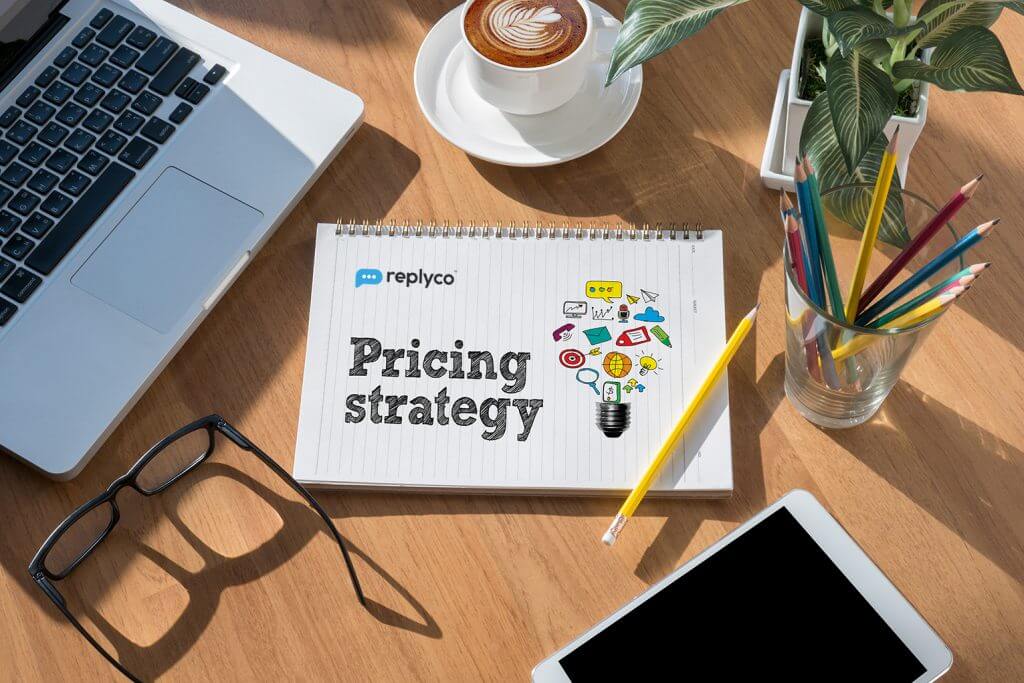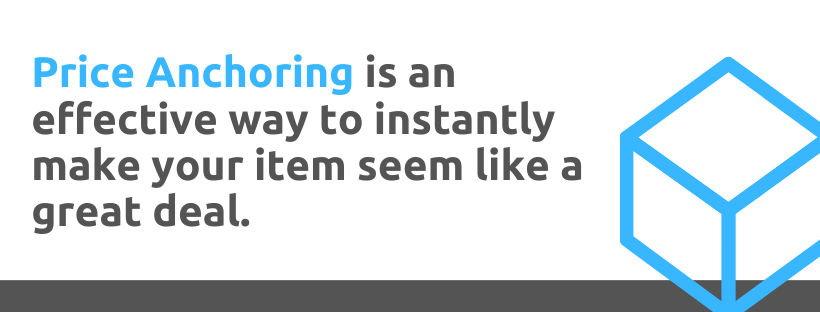23 Pricing Strategies Any eCommerce Seller Can Use to Increase Sales

Pricing strategies employ shopping science and psychology to improve eCommerce sales. Use this comprehensive guide to determine the best ones for your business.
Anyone who works in the eCommerce industry knows that psychology and pricing strategies play a huge role in shaping buyer behavior. Just a quick Web search about how to achieve online selling success will yield countless results discussing the topic of pricing strategy.
But if you pull up three different articles on the subject, you may find that each one offers a completely different list of strategies. It can be very easy to get overwhelmed by questions and concerns. “Which approach is right for me? Do some work better than others?”
As always, Replyco has your back. We’ve compiled 23 of the most talked about pricing strategies into one easy-to-follow guide. Keep reading to learn more about the various methods for using psychology to set your prices and watch products fly off the (virtual) shelves.

Market Penetration
Penetration pricing is one of the most entry-level and common eCommerce pricing strategies. This approach is all about grabbing a large share of the market by setting your prices competitively.
Used with new products and services, penetration pricing is the practice of setting the initial price low in order to attract buyers to your offering and away from competitors. The primary objective here is to quickly reach a large share of the market and generate positive word of mouth.
Generally, after a low-priced introductory period, the product pricing will be increased to a more profitable margin. A lower price at the beginning will attract buyers to your shop, but the quality of your offering will keep them there even after the cost increases.
Benefits:
The upside with penetration pricing strategies are clear. When offering a lower price than your competitors on a similar item, you should be able to easily grab a large share of the market all at once. Additionally, if customers are satisfied with your product, they may become loyal to your brand after switching.
Risks:
The potential risks associated with penetration pricing are equally simple to predict. You may obtain lots of buyers while the prices are low, but they could just as quickly switch away from your brand when the price increases. This is why quality assurance and great customer service are paramount.
Market Skimming
When it comes to pricing strategies, penetration pricing and market skimming go hand in hand. While penetration pricing is all about setting a low introductory price in order to gain a large market share, market skimming offers a new product at a high starting price.
The psychology behind market skimming focuses on creating a strong buzz around a new product and setting it apart as a premium offering.
Think back to when Apple first introduced the iPhone. For mobile phone users, the starting price of the much-hyped iPhone was staggering. But that didn’t stop customers from lining up around the block to purchase the innovative piece of hand-held machinery. In fact, the iPhone sold out almost immediately.
Later, the price of the phone reduced to a more affordable rate, which happens to be the second step in market skimming. After introducing your product at a premium, you later drop it to a more economical price. This enables you to grab two shares of the buyer market: the “have to have it first” buyers, and the shoppers that are willing to wait for a cost decrease.
Benefits:
The upside of market skimming is that eCommerce sellers have the chance to create a buzz around a new product and attempt to establish it as a premium item. Additionally, selling at a higher price can result in large profit margins while also helping you obtain a segmented market share.
Risks:
Introducing a product at a high price can also potentially backfire. What if customers don’t see the value in your product at the price point you’ve set? It is important to carefully pick and choose the products for which you use this strategy. A first-of-its-kind offering has a much better chance of performing well than a variation on a product that already exists.

Numbers Psychology
We’ve all seen tons of commercials and online ads that include language such as “all for the low price of $19.99!” But do those kinds of odd prices actually help drive up sales?
Studies suggest that yes, they certainly do. Using numbers psychology in pricing strategies operates on the notion that shoppers are more likely to recognize a deal when it is presented as a non-round figure.
For example, even though $19.99 is essentially the exact same as $20, buyers automatically recognize it as less. It is this same thinking that will lead shoppers to be more likely to buy something for $99.95 than for $100. Just the simple appearance of such non-round numbers gives the impression that the product is being offered at a deal.
Benefits:
The positive side to numbers psychology is that the price is presented in a way that catches the buyer’s eye. Listing figures that are uneven communicates that the product is being offered at a deal or special price, psychologically compelling shoppers to buy.
Risks:
A potential con is that many shoppers are aware of this strategy. That said, it still tends to work on all of us when we are browsing items.
Pain Points
When it comes to pricing strategies, here’s one every eCommerce seller should use: addressing customer pain points.
The way to address pain points in a pricing strategy is simple. You just consider what issues a shopper for your item might face pertaining to cost and discuss them in your listing. For example, if you sell crafting supplies on Amazon, try product listing language such as, “Why pay more for sidewalk chalk when you can get it here for less?”
Directly addressing your customer’s pain points and how your pricing alleviates them can go a long way toward increasing your sales and keeping buyers coming back for more. Of course, this strategy only works on economically priced items. If your products cost significantly more than your competitors’, the above statement would be untrue and could backfire. Be sure to address pain points in ways that are honest and accurate to your offerings.
Benefits:
The pain point pricing strategy tells customers exactly how your product’s cost will meet their budgetary needs, resulting in better sales and happier shoppers.
Risks:
This method should only be used if what you are saying is actually true. For instance, if you inaccurately claim to offer the lowest price on an item, you could wind up deterring customers rather than attracting them.

Economy
Practically every shopper in the world has taken advantage of economy pricing strategies at some point or another. This technique involves offering a low-priced but similar-in-function alternative to name-brand items.
Generic medications and store-brand sodas are a great example of economy pricing. These products offer virtually the same exact features and benefits of their name-brand counterparts, but for sometimes significantly lower costs.
Your main objective when selling economy products is to make a profit off of volume sold. If you sell discount tissue, for example, you may only make $1 on each item sold — but you could easily sell hundreds of them thanks to attractive pricing.
Benefits:
The upside to economy pricing is that you can make your profit from selling a large number of items. Attractive prices tend to keep shoppers coming back for more and encourage steady business.
Risks:
The potential downside to economy pricing is that it can lead to being very busy. Of course as an online seller, you want to be busy, but you also need to be sure you are equipped to handle a high volume of orders. Also, this approach means you make your profit off of lots of little sales. So you will need to ensure you keep items stocked and available to buyers.
Decoy
One of the most tried-and-true pricing strategies in history is decoy pricing. This method involves offering multiple similar items at different price points in order to influence shoppers to go for a specific one.
An extremely recognizable example of this technique is evident in movie theaters. If you are in line at the concession stand and see three different drink options: small, medium and large, which one do you choose? Countless studies have shown that most people choose medium. This is because they believe a small will be too little and a large will be exorbitant.
In reality, the movie theater wants you to choose the medium, because that’s where they make the highest profit margin. The amount of product in the medium cup is hardly more than the amount in a small, but the theater will make more money off of it.
Decoy pricing works like this: when presented with three options, customers overwhelmingly select the median. So make the product you actually want to sell the median option and offer a low-end decoy option and a high-end decoy option.
Benefits:
The benefit of decoy pricing is clear: it enables you to make your target product seem more attractive by offering higher and lower priced / featured options.
Risks:
With decoy pricing, figuring out the right price point for each option can prove challenging. It is important to set your median product’s cost at a rate that is competitive with similar items available from other sellers, while your high- and low-end products should be priced in a range that makes sense for the features offered.

Compromise Option
Similar to the decoy methodology, the compromise option pricing strategy also uses comparison to make a specific product more attractive.
In this case, sellers typically present two items. One product will be slightly high-priced with potentially more features than the average shopper needs. The other product (the one you are actually trying to sell) will be fairly priced and framed as an ideal compromise of features and cost.
A higher priced item effectively makes the target product much more attractive by comparison. Shoppers are frequently left with the mindset, “I don’t want to spend more for features I don’t need, so this product fits perfectly with my wants and budget.”
Benefits:
The upside of compromise pricing strategies is that you are presenting your store as a place where shoppers can get what they need and want at a good price. This method can enable you to position yourself as a leader in matching your offerings with customer needs. Additionally, you may also still sell some of the higher priced items, as certain buyers will still go for the full-featured version.
Risks:
When it comes to compromise options, one risk to avoid is framing your product as too much of a bargain. You want the item you’re selling to seem like a great deal, but not like a low-end choice. Finding the right balance between value and features is key.
Premium Option
The flipside of the compromise pricing strategy is the premium option. This method offers a premium item that, even though it might be expensive, seems more attractive when positioned next to a bare-bones product.
Companies such as Apple and luxury fashion designers are famous for using such techniques. Their products may be more expensive than similar ones on the market, but they offer customers the idea of having the “best of the best.”
In eCommerce, a great way to employ premium pricing strategies is to contrast your target item with an ultra-cheap product that doesn’t quite meet shoppers’ needs. For instance, if you sell quality crafting supplies, you might explain in the product listings what makes your items better. In this case, you could compare cheap oil paints with your top-quality offerings and explain that shoppers are getting much better pigmentation for just a little bit more money.
Benefits:
Obviously, the best part of using the premium option pricing strategy is that it enables you to establish your store as one that offers high-quality merchandise. You can also increase your per-item profit margins by selling bigger ticket products.
Risks:
The main con for the premium option is similar to the risk involved with the compromise method. You need to be very mindful of how you set your prices. Do your research and don’t go so high that you price yourself out of being able to compete with other stores.

Price Anchoring
Another one of the pricing strategies we’ve all seen is price anchoring. This approach refers to the practice of establishing a static price to which customers can refer when making decisions.
Price anchoring is evident on television ads for products. No matter what the sale price is for an item being advertised, you will undoubtedly first hear something about the product’s “original price.” For instance, a commercial may go something like, “This product was $100, but we’ve slashed the price to $75.”
In the above scenario, the anchor price is $100. That number makes the sale price seem more attractive because customers believe they are getting a deal or a discount. Price anchoring is all about keeping the original price the same, while explaining that you are offering the item for less.
Another way to use price anchoring is to refer to your competition. You could say something like, “While other sellers list this item for as much as $100, we are offering it for $75!”
Benefits:
Price anchoring is a great way to instantly make your item seem like a great deal, thereby increasing the odds that shoppers will add it to their cart.
Risks:
When using this strategy, it is important to keep the anchor price believable. If you go too high with what you claim your competition sells an item for, or what you say the original price was, customers will feel like you are trying to mislead them.
Volume
One of the pricing strategies that allows you to encourage customers to buy more of your products is volume pricing. This method offers incremental price decreases based on volume purchased.
For example, if you’re selling tickets to an event, you might make the following offer: “Tickets sold individually for $12 each, or in groups of 10 or more for $6 each.” In this case, you will charge $12 for individual tickets sold, but are offering shoppers a 50% discount if they purchase 10 or more at a time.
Benefits:
The obvious upside to volume pricing is that you encourage shoppers to purchase a higher quantity of items. You may make less per item, but the dramatic increase in sales can improve your ROI. eCommerce sellers who utilize volume pricing strategies also frequently experience improvements in brand loyalty because the bulk deals keep shoppers coming back to their store.
Risks:
The one primary risk with this method is that you won’t make as much profit per item when shoppers purchase in higher increments. This is why it is important to be strategic about where you set your prices. Make sure customers are getting an attractive price while also ensuring your profit margin is ideal.

Freebies
We can’t talk about pricing strategies without discussing a perennial customer favorite: freebies. Offering free items that come with the purchase of a product can make buying from you extremely beneficial to shoppers.
Examples of freebies are endless, but can include perks such as:
- Free shipping for spending over $30
- Two free ink cartridges with the purchase of a printer
- Complimentary makeup bag with the purchase of cosmetics
- Free paint brushes with the purchase of oil paints
While the list goes on and on, the key is to offer a free item that is useful with, or relevant to, the purchased product.
Benefits:
The upsides to offering freebies are clear. First of all, you are making your offerings much more attractive, thereby dramatically improving your odds of selling more items. Additionally, you are encouraging positive outcomes such as brand loyalty, satisfied customers and favorable reviews.
Tip: Another benefit of freebies is that you can use this method to unload excess inventory. For instance, if you are getting rid of summer stock to make room for fall inventory, you can offer your summer items at a discount and also as freebies, such as, “50% of all swimsuits + free pair of sunglasses with every purchase.”
Risks:
The primary risk when it comes to offering free items with purchases is that you need to make sure you can afford to do so. Don’t offer freebies that will dig too deeply into your profit margin, and also be sure to set your product prices correctly and competitively.

Extras / Optional Products
Another pricing strategy that allows you to provide great value to customers is the extras or optional products method. With this approach, you offer various features or add-ons with a product at different price points.
For example, a printer you sell might come with the following options:
- Just the printer for $59.99
- Printer + extra ink for $65.99
- Printer + extra ink + paper for $67.99
In this scenario, the added features might cost a bit less when purchased in the bundle than they would if bought separately.
Benefits:
The benefit of offering extras is similar to the upside to freebies. Both methods help you make purchases more attractive. With this approach, you are also able to tailor your offerings to address unique customer needs. In the above scenario, for instance, one customer might only need a printer while another might need the entire bundle. You are also increasing your odds of making more on each sale by marketing the higher-priced bundles.
Tip: As with freebies, extras / optional products also allow you to strategically move inventory to make room for new items. Be sure to promote exciting bundle discounts on anything you need to clear from your storeroom.
Risks:
When utilizing the extras / optional products strategy, it is important to make sure you are offering product bundles that make sense. Keep the items relevant to one another. For example, don’t offer sunglasses as an add-on with printers. You also need to set your prices optimally for both profit and sellability.
Captive
Captive pricing is similar to extras / optional products, except it involves additional items a customer has to purchase. A great example of captive pricing is branded ink. Many printers require the use of branded ink in order to function properly.
When selling products that result in captive pricing, you are ensuring repeat sales. Many sellers who use this method offer subscription plans to customers for items such as ink, in which new cartridges are automatically purchased and delivered on an incremental basis (such as every three months).
Benefits:
A major benefit to pricing strategies such as captive pricing is the fact that shoppers must keep returning to your store. Obviously, if you sell products that result in captive customers, you can dramatically increase your odds of making repeat sales. Additionally, you are able to set the prices of captive items at any rate you choose, especially if you are an exclusive provider of the product. If customers have no other choice but to buy something from you, you have a lot of control over how much to charge.
Risks:
It may be a cliche, but with great power comes great responsibility. Be sure to avoid “gotcha” pricing on captive items. You might sell products customers have to come back for, but they will be resentful if you gouge prices because of it. Setting your prices too high will lead to shoppers looking elsewhere for what they need. Be strategic in setting costs that result in an adequate profit margin for you, but also in a fair price for your customers.

Dynamic
Dynamic pricing, also referred to as surge, demand or time-based pricing, is a pricing strategy in which sellers base prices on current market demands.
We’ve very recently seen this strategy at play during times of crisis. As products such as hand sanitizer, surface disinfectant and paper products became difficult to find, companies that offered them were able to charge much higher prices than normal. And customers still bought them willingly (so much so that many vendors had to enforce per-transaction quantity limits).
As the supply of these items begins to replenish across the globe, the demand, in turn, decreases — as do the prices.
Benefits:
With dynamic pricing strategies, the benefit is being able to make a sizable profit on items that are in high demand. During times when the public is clamoring for the products you offer, you can dramatically increase sales. This method is also helpful in allowing you to establish a good relationship with customers by providing what they need when they need it.
Risks:
As stated, you can make a lucrative profit with demand pricing. However, it is important to consider your customers. Don’t set prices so high that they end up resenting your company or feeling like you are taking advantage of their needs. Building a good reputation during times of heavy demand can establish you as a trusted leader in your industry.
Limited-Time Promotions
Among the pricing strategies that lead to quick results, limited-time promotions often reign supreme.
Offering a limited-time-only price engages shoppers and encourages immediate purchase. Think about it. Which of the following product listings would be more likely to drive you to action?
- “New Laptop: $899.99!”
Or…
- “New Laptop: $899.99 TODAY ONLY!”
For many shoppers who have been even slightly considering buying a new laptop, the second ad could be just the push they need to go ahead and make the purchase. That’s because the language used suggests that if they wait until later to buy it, they could end up paying more.
There are many great ways to offer limited-time promotions. You can set a price for a specified amount of time, offer a free trial, advertise extra freebies on purchases within a certain timeframe, etc.
Benefits:
The most useful benefit of limited-time promotions is that they influence shoppers to act quickly in order to secure whatever deal is on offer. This pricing strategy also results in higher sales thanks to playing on the psychology of customers who don’t want to miss out on a deal (in other words, customers who may not have purchased at all will be more likely to buy).
Risks:
The key to successful limited-time pricing is to make sure you are offering deals that make sense for your company. Keep prices at a point that ensures profits stay where you need them to. Also, don’t hype something that isn’t really true or a good deal. Customers will see through that sort of bogus marketing. For example, if you’re advertising a price as “today only,” make sure it is actually lower than it was the day before — even if only by a small amount.

Coupons & Deals
When it comes to pricing strategies, coupons and deals are a great way to not only increase sales, but also to encourage customers to seek out information on your brand.
Coupons and deals can entice shoppers to be loyal to your company and to search for ways to get the most bang for their buck. From offering coupon codes that can be copied from deals sites to giving special discounts for signing up for email updates, sellers can provide loyal customers with a myriad of ways to save money.
Benefits:
Brand loyalty is a huge benefit of the coupons and deals pricing strategy. When you offer customers various opportunities for saving money, they are much more likely to continue shopping with you. This method is also a great way to improve your industry reputation and recognition in the marketplace. By getting your name out there on various deals sites and other external outlets, you are increasing your reach.
Risks:
When offering deals, make sure you can afford to do so. Don’t set prices so low when coupons are applied that you negatively affect your profit margins. Also, don’t confuse shoppers with way too many offers at once. Keep things simple and exciting, not overwhelming.
Value-Based
Value-based pricing is a pricing strategy which sets prices in accordance with the product’s perceived value to the customer rather than its actual value.
The most easy-to-understand example of value-based pricing comes from the art world. Creating a new painting may only take an artist a few hours or days to produce, and the materials the artist uses could be fairly inexpensive. But, depending on the perception of the person who purchases the piece, it could sell for an astronomical price.
We see this method at play in all sorts of product categories. Many items are relatively inexpensive to produce, but are accepted as being sold at much higher prices. The best way to price your items in accordance with value-based methods is to research what customers are willing to pay for similar products.
Benefits:
The upside of value-based pricing is that you are usually able to make a decent profit margin off of an item that is fairly inexpensive to acquire or create as a seller. This technique also allows you to fulfill customer needs and adjust your prices according to demand.
Risks:
The risks involved with value-based pricing are similar to those associated with dynamic pricing. You will need to avoid the appearance of gouging. Don’t set prices so high that you are perceived as taking advantage of customers.

Market Research
Another one of the most helpful pricing strategies is market research. You need to study what your competitors are doing, as well as what customers are already willing to pay for certain types of products.
This due diligence will really help to give you a better understanding of where you should set your prices.
Benefits:
The benefit of market research is that it gives a good starting point when you’re just beginning to set prices. This method enables you to make sure you aren’t charging way too much or way too little for specific items.
Risks:
There are no real cons with conducting market research, aside from the fact that it can take some time. When done right, however, it can go a long way toward helping you set the right prices for increasing sales.
Comparison
We’ve already discussed the pricing strategies of decoy, compromise and premium. In those instances, shoppers are buying an item based on comparing its features and cost with other higher- or lower-end offerings.
The pricing strategy that is actually called comparison pricing is different from those methods. Perhaps the best way to explain this technique is to talk about Esurance. During the early days of Esurance commercials, they aired very unique advertisements. In them, the company talked about how they would help customers compare insurance rates and features from all companies, even if Esurance wasn’t the lowest price.
This pricing strategy is all about building trust. It’s not just about selling your product as the top-quality option, nor is it all about presenting your items as the best deal available. Instead, it’s about framing your overall company, product and offering as the ideal total package. You are telling customers that you believe you offer the best product for the most fair price, but that you are also willing to be fully transparent with them so they can make the right choice for their needs.
Benefits:
The main benefit to comparison pricing strategies is they enable you to build trust and rapport with customers. By comparing your store with other companies, you show buyers that you are open, honest and potentially the best choice for them.
Risks:
The potential risk with comparison pricing is that it can be difficult to do correctly. In order to safely deploy this technique, you need to be sure your products are high-quality and that your prices compare favorably with the competition. Otherwise, you could wind up driving shoppers to buy from someone else.

Experience Marketing / Event Pricing
Pricing strategies that involve event pricing revolve around selling an experience. For example, when a band comes out of retirement to do a one-night-only show, the ticket prices for the concert are naturally going to be set at a high premium.
Exciting events are priced in accordance with the experience a buyer is afforded when making the purchase. Additionally, these prices need to be set at a rate that recoups certain expenses, such as decorating, venue rental, talent costs and more.
When it comes to eCommerce, event pricing might revolve around situations such as exclusive webinars or signed copies of a highly anticipated new book (for example, autographs may be available for an extra fee).
Benefits:
The benefit of event pricing is that prices are based on user experience. Much like value-based pricing, these rates can result in significant profits for the seller. You are also able to offer buyers unique and special adventures or products that are possibly unlike anything they can get anywhere else.
Risks:
The primary risk associated with event pricing is that you need to be dutiful about how you set rates. Putting on experiences or shows can be costly to the organizer (you), so be sure to set prices that recoup your expenses while still enticing buyers to purchase.
Simplicity
One pricing strategy that plays heavily on visual preferences and psychology is simplicity pricing.
The basis of simplicity pricing is that shoppers perceive numbers differently depending on how they are written out. See the examples below:
- $39
- $39.00
In the example, both numbers represent the exact same amount. However, studies have shown that customers are more likely to purchase the item that is priced simply at $39. This is because, to our eyes, it seems like less and also catches our attention more effectively.
Benefits:
This is a very straightforward pricing strategy with a clear upside: simplicity. By showing your prices in a simple, clear way, you increase your odds of making a sale.
Risks:
There are no real cons with simplicity pricing. Just make sure to set prices at an optimal range for both profit margin and affordability.
Weber’s Law
Here’s another pricing strategy that utilizes psychology. In layman’s terms, Weber’s Law states that how much we notice a change is proportional to the original price.
Under Weber’s Law, the cost of a high-priced item can be changed significantly without having a dramatic effect on sales. Conversely, the cost of an already low-priced item can be changed minimally, but experience a huge difference in sales.
For instance, studies have shown that big-ticket items such as cars can see little-to-no change in sales even if the prices have increased by a wide margin. However, increasing the price on an already-inexpensive product such as body wash can result in a massive sales drop.
eCommerce sellers can use this technique to their advantage. By decreasing the price minimally on small-ticket items, you could encourage a significant increase in the number of items sold.
Benefits:
The benefit of using Weber’s Law is that you can encourage sales improvement on smaller items with minute changes in the actual prices, meaning you aren’t really diminishing your per-item profit.
Risks:
One risk involved with this method is that it can be tricky to master. The best way to figure out which items perform best with small price decreases is to utilize the following pricing strategy as well, which is A / B split testing.

A / B Split Test
Figuring out the best pricing strategy can often be a matter of trial and error. You need to research your shoppers’ habits and research which prices tend to perform best.
A great way to do this is to utilize A / B split testing. This method involves trying different price points on the same product in order to determine which ones result in the highest sales or best profit margins.
If you sell products on different platforms (Amazon, eBay, etc.), you might want to try setting different prices for the same item. For instance, you could sell a printer for $59.99 on Amazon and sell the same one on eBay for $61.99. The better performing of the two could very well surprise you.
You can also try selling different types of bundles to see which ones attract the most shoppers.
Benefits:
The benefit to A / B split testing is that it enables you to gauge what’s working and what isn’t. You can then hone your pricing strategies to fit the behavior of your specific demographic.
Risks:
The main risk with A / B split testing is that it can be time-consuming to do. It is, however, an integral part of developing the most optimal strategy for your business.
Use Pricing Strategies that Work for You
We’ve talked about a lot of pricing strategies in this article. But at the end of the day, you have to do what’s right for you. What works for one person’s business may be the exact opposite of what works for someone else’s.
Do your research, try different approaches and don’t be afraid to make mistakes. Most importantly, keep customer satisfaction at the heart of everything you attempt to do.
In the eCommerce industry, making customers happy is always going to be the very best sales strategy of them all. If you’d like to learn more about how Replyco can help you respond to customers more quickly by organizing your inbox, feel free to take a tour of our features or start your free trial today!





